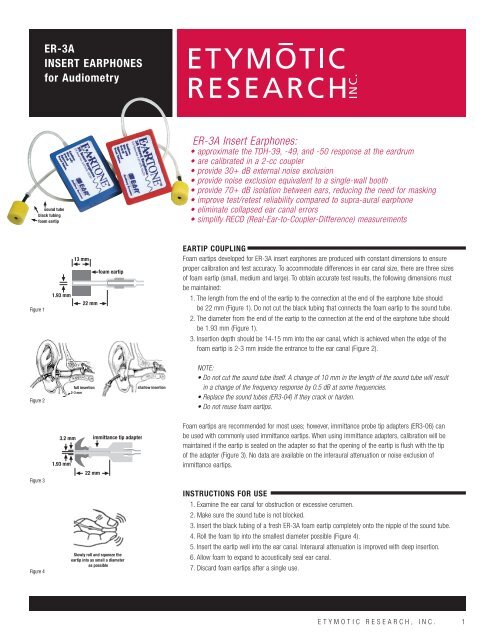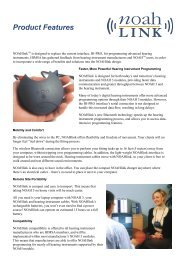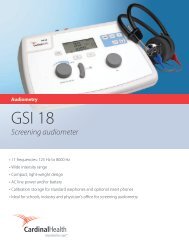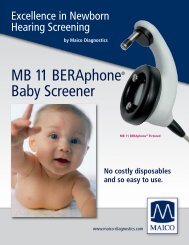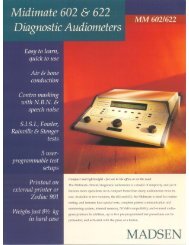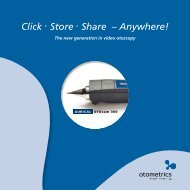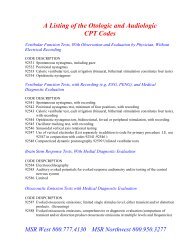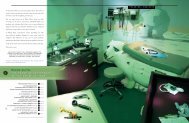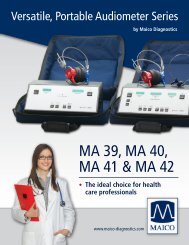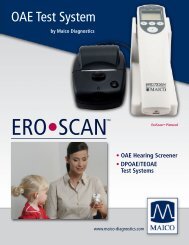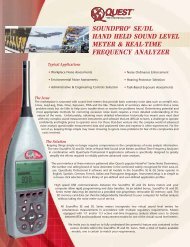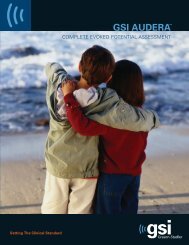ER-3A Insert Earphones - Audiomed, Inc.
ER-3A Insert Earphones - Audiomed, Inc.
ER-3A Insert Earphones - Audiomed, Inc.
Create successful ePaper yourself
Turn your PDF publications into a flip-book with our unique Google optimized e-Paper software.
<strong>ER</strong>-<strong>3A</strong><br />
INS<strong>ER</strong>T EARPHONES<br />
for Audiometry<br />
sound tube<br />
black tubing<br />
foam eartip<br />
Figure 1<br />
Figure 2<br />
Figure 3<br />
Figure 4<br />
1.93 mm<br />
3.2 mm<br />
1.93 mm<br />
13 mm<br />
22 mm<br />
22 mm<br />
foam eartip<br />
immittance tip adapter<br />
Slowly roll and squeeze the<br />
eartip into as small a diameter<br />
as possible<br />
<strong>ER</strong>-<strong>3A</strong> <strong>Insert</strong> <strong>Earphones</strong>:<br />
• approximate the TDH-39, -49, and -50 response at the eardrum<br />
• are calibrated in a 2-cc coupler<br />
• provide 30+ dB external noise exclusion<br />
• provide noise exclusion equivalent to a single-wall booth<br />
• provide 70+ dB isolation between ears, reducing the need for masking<br />
• improve test/retest reliability compared to supra-aural earphone<br />
• eliminate collapsed ear canal errors<br />
• simplify RECD (Real-Ear-to-Coupler-Difference) measurements<br />
EARTIP COUPLING<br />
Foam eartips developed for <strong>ER</strong>-<strong>3A</strong> insert earphones are produced with constant dimensions to ensure<br />
proper calibration and test accuracy. To accommodate differences in ear canal size, there are three sizes<br />
of foam eartip (small, medium and large). To obtain accurate test results, the following dimensions must<br />
be maintained:<br />
1. The length from the end of the eartip to the connection at the end of the earphone tube should<br />
be 22 mm (Figure 1). Do not cut the black tubing that connects the foam eartip to the sound tube.<br />
2. The diameter from the end of the eartip to the connection at the end of the earphone tube should<br />
be 1.93 mm (Figure 1).<br />
3. <strong>Insert</strong>ion depth should be 14-15 mm into the ear canal, which is achieved when the edge of the<br />
foam eartip is 2-3 mm inside the entrance to the ear canal (Figure 2).<br />
NOTE:<br />
• Do not cut the sound tube itself. A change of 10 mm in the length of the sound tube will result<br />
in a change of the frequency response by 0.5 dB at some frequencies.<br />
• Replace the sound tubes (<strong>ER</strong>3-04) if they crack or harden.<br />
• Do not reuse foam eartips.<br />
Foam eartips are recommended for most uses; however, immittance probe tip adapters (<strong>ER</strong>3-06) can<br />
be used with commonly used immittance eartips. When using immittance adapters, calibration will be<br />
maintained if the eartip is seated on the adapter so that the opening of the eartip is flush with the tip<br />
of the adapter (Figure 3). No data are available on the interaural attenuation or noise exclusion of<br />
immittance eartips.<br />
INSTRUCTIONS FOR USE<br />
1. Examine the ear canal for obstruction or excessive cerumen.<br />
2. Make sure the sound tube is not blocked.<br />
3. <strong>Insert</strong> the black tubing of a fresh <strong>ER</strong>-<strong>3A</strong> foam eartip completely onto the nipple of the sound tube.<br />
4. Roll the foam tip into the smallest diameter possible (Figure 4).<br />
5. <strong>Insert</strong> the eartip well into the ear canal. Interaural attenuation is improved with deep insertion.<br />
6. Allow foam to expand to acoustically seal ear canal.<br />
7. Discard foam eartips after a single use.<br />
ETYMOTIC RESEARCH, INC. 1
ANSI S3.6 AND ISO 389.2 REF<strong>ER</strong>ENCE THRESHOLDS<br />
Sound Pressure Levels in dB re. 20µPa<br />
Occluded Ear HA-2 with<br />
Frequency (Hz) Simulator Rigid Tube HA-1<br />
125 28.0 (98.0) 26.0 (96.0) 26.5 (86.5)<br />
250 17.5 (87.5) 14.0 (84.0) 14.5 (84.5)<br />
500 9.5 (79.5) 5.5 (75.5) 6.0 (76.0)<br />
750 6.0 (76.0) 2.0 (72.0) 2.0 (72.0)<br />
1000 5.5 (75.5) 0.0 (70.0) 0.0 (70.0)<br />
1500 9.5 (79.5) 2.0 (72.0) 0.0 (70.0)<br />
2000 11.5 (81.5) 3.0 (73.0) 2.5 (72.5)<br />
3000 13.0 (83.0) 3.5 (73.5) 2.5 (72.5)<br />
4000 15.0 (85.0) 5.5 (75.5) 0.0 (70.0)<br />
6000 16.0 (86.0) 2.0 (72.0) -2.5 (67.5)<br />
8000 15.5 (85.5) 0.0 (70.0) -3.5 (66.5)<br />
Table 1<br />
40<br />
Reference Equivalent<br />
Threshold SPL in dB<br />
30<br />
20<br />
10<br />
0<br />
COMPARISON OF ANSI-1989 AND ANSI-1996<br />
Measured in HA-1 2cc Coupler<br />
-10<br />
100 1000<br />
Frequency (Hz)<br />
10000<br />
ANSI-1989 WILB<strong>ER</strong> et al. (1988) ANSI-1996<br />
Figure 6<br />
40<br />
Reference Equivalent<br />
Threshold SPL in dB<br />
30<br />
20<br />
10<br />
0<br />
COMPARISON OF ANSI-1989 AND ANSI-1996<br />
Measured in DB-0138 2cc Coupler<br />
-10<br />
100 1000<br />
Frequency (Hz)<br />
10000<br />
ANSI-1989 ANSI-1996<br />
Figure 7<br />
40<br />
Reference Equivalent<br />
Threshold SPL in dB<br />
Relative Response in dB<br />
20<br />
10<br />
0<br />
-10<br />
-20<br />
30<br />
20<br />
10<br />
0<br />
<strong>ER</strong>-<strong>3A</strong> RESPONSE IN THREE COUPL<strong>ER</strong>S<br />
-30<br />
100 1000<br />
Frequency (Hz)<br />
10000<br />
Zwislocki Coupler HA-1 DB-0138<br />
Figure 5<br />
COMPARISON OF ANSI-1989 AND ANSI-1996<br />
Measured in Occluded Ear Simulator<br />
-10<br />
100 1000<br />
Frequency (Hz)<br />
10000<br />
ANSI-1989 ANSI-1996<br />
Figure 8<br />
2 ETYMOTIC RESEARCH, INC.<br />
<strong>ER</strong>-<strong>3A</strong> INS<strong>ER</strong>T EARPHONE<br />
CALIBRATION IN A 2CC COUPL<strong>ER</strong><br />
Table 1 shows the Reference Equivalent Threshold Sound Pressure Levels (RETSPLs) measured in three<br />
couplers. The couplers are:<br />
1. An occluded ear simulator as described in ANSI S3.7 and IEC 711 that closely replicates the acoustic<br />
properties of the average ear canal and eardrum. ANSI standard 3.6-1996 calls for the HA-2 sound<br />
channel to be substituted for the sound channel in the eartip.<br />
2. An HA-1 2cc coupler with the <strong>ER</strong>-3 eartip sealed to the top surface of the coupler.<br />
3. An HA-2 2cc coupler with rigid tube. In this case the sound channel of the coupler is substituted for<br />
the sound channel in the eartip.<br />
Audiometer calibration is normally performed at a dial setting of 70 dB HL. The calibration targets shown in<br />
parentheses next to the RETSPL numbers in Table 1 were obtained by adding 70 dB to each RETSPL number.<br />
<strong>ER</strong>-<strong>3A</strong> RESPONSE IN THREE COUPL<strong>ER</strong>S<br />
The numbers in Table 1 were chosen to produce the same calibration regardless of coupler. In other words,<br />
an earphone calibrated to 70 dB SPL at 1 kHz in either of the 2cc couplers should produce 75.5 dB SPL at<br />
the average eardrum or in an occluded ear simulator.<br />
Figure 5 shows the frequency response of an <strong>ER</strong>-3 earphone measured in each of three couplers. For the<br />
Zwislocki coupler (ear simulator) curve, the <strong>ER</strong>-<strong>3A</strong> eartip was sealed directly into the coupler rather than<br />
through an HA-2 sound channel as specified in ANSI S3.6-1996. The response measured with the eartip<br />
sealed into the coupler is nearly identical to the average eardrum pressure produced by an insert earphone<br />
such as the <strong>ER</strong>-<strong>3A</strong> (Sachs and Burkhard, 1972). The HA-2 sound channel introduces an extraneous highfrequency<br />
boost in the coupler measurement.<br />
COMPARISON OF ANSI S3.6 1989 AND ANSI S3.6 1969<br />
Figures 6 through 8 show the RETSPLs from ANSI S3.6-1989 and ANSI S3.6-1996. The 1996 values<br />
were based on only three studies (two European and one US), but were adopted in the U.S. in the interest<br />
of international harmony. The 1996 values are, nonetheless, the ones to be used for normal audiometer<br />
calibration in order to comply with legal requirements for proper calibration.<br />
For purposes of hearing research, the ANSI S3.6-1989 values should be considered: They were originally<br />
based on a compilation of 35 studies from 1928 to 1977 (Killion, 1978), and validated by five threshold<br />
studies using the <strong>ER</strong>-<strong>3A</strong> insert earphone and summarized by Wilber et al. (1988). The ANSI 1989 ear<br />
simulator RETSPL numbers in Figure 8 are the same as the Minimum Audible Pressure at the Eardrum<br />
(MAPD) numbers described by Killion (1978).<br />
CALIBRATION FOR SPEECH AUDIOMETRY<br />
Calibration of <strong>ER</strong>-<strong>3A</strong> insert earphones for speech is performed by the following method:<br />
1. Set a 1 kHz signal at 0 VU through the speech circuit.<br />
2. Set the attenuator dial to 60 dB HL.<br />
3. Adjust the speech circuit on the audiometer to measure 72.5 dB in a 2-cc coupler.<br />
The ANSI standard specifies that a 1 kHz reference tone level for the speech circuit should be 12.5 dB<br />
above a 1 kHz reference test threshold for any earphone. The 1 kHz RETSPL for <strong>ER</strong>-<strong>3A</strong> is 0 dB SPL.<br />
(60 + 0 + 12.5 = 72.5). A range of 69.5 to 75.5 dB meets the ±3 dB tolerance allowed in the ANSI<br />
standard.
10<br />
Standard Deviation<br />
Across Subjects in dB<br />
0<br />
100 1000<br />
Frequency (Hz)<br />
10000<br />
<strong>ER</strong>-<strong>3A</strong> TDH <strong>Earphones</strong><br />
Figure 9<br />
Real-ear Attenuation in dB<br />
8<br />
6<br />
4<br />
2<br />
0<br />
10<br />
20<br />
30<br />
40<br />
50<br />
60<br />
100 1000<br />
Frequency (Hz)<br />
10000<br />
Figure 10<br />
Interaural Attenuation in dB<br />
20<br />
30<br />
40<br />
50<br />
60<br />
70<br />
80<br />
TEST RELIABILITY<br />
EXT<strong>ER</strong>NAL NOISE EXCLUSION OF 3 EARPHONES<br />
TDH-50 + MX-41/AR <strong>ER</strong>-<strong>3A</strong> <strong>ER</strong>-5<br />
INT<strong>ER</strong>AURAL ATTENUATION OF TDH AND <strong>ER</strong>-<strong>3A</strong> EARPHONES<br />
Interaural Attenuation in dB<br />
40<br />
50<br />
60<br />
70<br />
80<br />
90<br />
100<br />
Figure 11<br />
125 250 500 1000<br />
Frequency (Hz)<br />
2000 4000 8000<br />
0<br />
10<br />
TDH-39 <strong>ER</strong>-<strong>3A</strong><br />
INT<strong>ER</strong>AURAL ATTENUATION<br />
both eartips<br />
shallow<br />
90<br />
100<br />
both deep<br />
one deep<br />
125<br />
Figure 12<br />
250 500 1000<br />
Frequency (Hz)<br />
2000 4000 8000<br />
<strong>ER</strong>-<strong>3A</strong> INS<strong>ER</strong>T EARPHONE<br />
RELIABILITY<br />
Traditional supra-aural earphones have several limitations. Among them are:<br />
1. Poor noise exclusion at low frequencies, which invalidates tests done outside a sound booth.<br />
2. Low interaural attenuation.<br />
3. Erroneous high-frequency thresholds resulting from collapsed ear canals when using the traditional<br />
MX-41AR earphone cushions.<br />
<strong>Insert</strong> earphones eliminate all three of these problems. Wilber et al. (1988) also found less variability<br />
across subjects using insert earphones (Figure 9).<br />
EARTIP INS<strong>ER</strong>TION<br />
The purpose of deeply inserted eartips is to maximize interaural attenuation and noise exclusion, but there<br />
is usually less than a 3 dB difference in eardrum pressure (i.e., threshold) between shallow and deeply<br />
placed eartips.<br />
EXT<strong>ER</strong>NAL NOISE EXCLUSION<br />
<strong>ER</strong>-<strong>3A</strong> insert earphones provide greater than 30 dB exclusion of background noise. As insertion depth<br />
increases the amount of attenuation increases. Deeply inserted <strong>ER</strong>-<strong>3A</strong> foam eartips can provide noise<br />
exclusion equivalent to a single-wall booth. Testing to audiometric zero can be done reliably whenever<br />
the SPL of the background noise is less than 45 dBA. Figure 10 shows the attenuation of four audiometric<br />
earphones. The <strong>ER</strong>-<strong>3A</strong> and <strong>ER</strong>-5A have significantly greater attenuation than traditional supra-aural<br />
earphones and circumaural earphones.<br />
INT<strong>ER</strong>AURAL ATTENUATION<br />
A comparison of the interaural attenuation of a TDH-39 and <strong>ER</strong>-<strong>3A</strong> insert earphone is shown in Figure 11.<br />
High interaural attenuation values reduce the need for masking air conduction thresholds when using insert<br />
earphones. In cases of severe bilateral conductive hearing loss, a masking dilemma (overmasking) occurs<br />
when a high level of masking in the non-test ear reaches the opposite (test ear) cochlea via bone conduction<br />
and elevates threshold in the test ear. Interaural attenuation is significantly higher with insert earphones,<br />
making it possible to use lower masking levels in the non-test ear.<br />
The interaural attenuation of the <strong>ER</strong>-<strong>3A</strong> insert earphone increases with insertion depth. Figure 12 illustrates<br />
the importance of deep eartip insertion when maximum interaural attenuation is desired.<br />
REF<strong>ER</strong>ENCES<br />
1. American National Standards Institute. (1996) Specifications for Audiometers. (ANSI S3.6-1996). New York: ANSI.<br />
2. American National Standards Institute. (1999) Maximum Permissible Ambient Noise Levels for Audiometric Test Rooms<br />
(ANSI S3.1-1999). New York: ANSI.<br />
3. Berger EH, Killion MC (1989) Comparison of the noise attenuation of three audiometric earphones, with additional data on masking<br />
near threshold. J. Acoust. Soc. Am., 86 (4): 1392-1403.<br />
4. Clemis JD, Ballad WJ, Killion MC (1986) Clinical Use of an <strong>Insert</strong> Earphone. Annals Otol. Rhinol. Laryngol. 95 (5), 520-524.<br />
5. Frank T, Wright DC (1990) Attenuation Provided by Four Different Audiometric Earphone Systems. Ear and Hear 11(1) 70-78.<br />
6. Killion MC (1978) Revised estimate of minimum audible pressure: Where is the missing 6 dB? J. Acoust. Soc. Am., 63 (5), 1501-1508.<br />
7. Killion MC, Studebaker GA (1978) A-weighted equivalents of permissible ambient noise during audiometric testing. J. Acoust. Soc. Am.,<br />
63 (5), 1633-1635.<br />
8. Killion MC, Wilber LA, Gudmundsen GI (1985) <strong>Insert</strong> <strong>Earphones</strong> for More Interaural Attenuation. Hear Instruments, 36 (2), 34, 36.<br />
9. Killion MC, Villchur E (1989) Comments on "<strong>Earphones</strong> in Audiometry" [Zwislocki et al., J. Acoust. Soc. Am., 83, 1688-1689 (1988)]<br />
J. Acoust. Soc. Am., 85 (4), 1775-1778.<br />
10. Sachs RM, Burkhard M (1972) Pressure response in ears and couplers. IRPI Rep. 20021 to Knowles Electronics, Franklin Park IL.<br />
11. Wilber LA, Kruger B, Killion MC (1988) Reference Thresholds for the <strong>ER</strong>-<strong>3A</strong> earphone. J. Acoust. Soc. Am., 83 (2), 669-675.<br />
12. Yacullo WS (1999) Clinical Masking in Speech Audiometry: A Simplified Approach. Am. J. Audiol. 8, 106-116.<br />
ETYMOTIC RESEARCH, INC. 3
<strong>ER</strong>3-05<br />
<strong>ER</strong>1-02<br />
<strong>ER</strong>3-28S<br />
127 dB<br />
<strong>ER</strong>3-06X<br />
.2 msec<br />
1.0 msec<br />
126 dB<br />
<strong>ER</strong>3-21<br />
TYPICAL CLICK RESPONSE<br />
1V 100µsec clicks measured on KEMAR ®<br />
<strong>ER</strong>3-21ABR<br />
WARRANTY<br />
TDH-49<br />
<strong>ER</strong>-3/10<br />
<strong>ER</strong>3-06<br />
<strong>ER</strong>3-14C<br />
<strong>ER</strong>3-14A<br />
<strong>ER</strong>3-14B<br />
<strong>ER</strong>3-14E<br />
<strong>ER</strong>3-14D<br />
<strong>ER</strong>3-04<br />
<strong>ER</strong>3-06ABR<br />
<strong>ER</strong>3-26A<br />
<strong>ER</strong>3-26B<br />
Etymotic Research, <strong>Inc</strong>. warrants each insert earphone it<br />
manufactures to be free of defects in material and workmanship<br />
for a period of one year from the date of sale to the original<br />
purchaser. Etymotic Research’s obligation under this warranty is<br />
fulfilled, at <strong>ER</strong>’s option, by replacing the product in kind without<br />
charge to the original purchser, repairing the part, or crediting<br />
the original purchaser with the purchase price of the returned<br />
defective part. For a part to be covered by the warranty it must<br />
be returned to Etymotic Research, postage prepaid, within the<br />
warranty period, and the part must not show evidence of misuse,<br />
neglect, incorrect wiring by others, or improper installation.<br />
<strong>ER</strong>-<strong>3A</strong> INS<strong>ER</strong>T EARPHONE<br />
SYSTEM INCLUDES<br />
• <strong>Earphones</strong> (10 Ohm, 50 Ohm or 300 Ohm)–specify when ordering<br />
• Dual-mono 7' cable assembly<br />
• 50 foam eartips (regular, 13 mm)<br />
• 50 foam eartips (baby, 10 mm)<br />
• 2 foam eartips (jumbo, 18 mm)<br />
• Velcro clips<br />
<strong>ER</strong>-<strong>3A</strong> ACCESSORIES<br />
<strong>ER</strong>1-02 Dual-mono replacement 7' cable assembly 1/pkg<br />
<strong>ER</strong>3-04 Sound tube adapters 10/pkg<br />
<strong>ER</strong>3-05 Velcro clips 6/pkg<br />
<strong>ER</strong>3-06 Immittance probe tip adapters with front tubing 2/pkg<br />
<strong>ER</strong>3-06X Immittance probe tip adapters without front tubing 10/pkg<br />
<strong>ER</strong>3-14A Foam eartips (regular, 13 mm) 50/pkg<br />
<strong>ER</strong>3-14B Foam eartips (baby, 10 mm) 50/pkg<br />
<strong>ER</strong>3-14C Foam eartips (jumbo, 18 mm) 24/pkg<br />
<strong>ER</strong>3-14D 3.5 mm infant eartips 20/pkg<br />
<strong>ER</strong>3-14E 4 mm infant eartips 20/pkg<br />
<strong>ER</strong>3-21 Replacement sound tubes with adapters 4/pkg<br />
ABR V<strong>ER</strong>SION<br />
Etymotic’s ABR-version insert earphones are available only from ABR equipment manufacturers.<br />
<strong>ER</strong><strong>3A</strong>BR earphones require special connectors and other proprietary modifications. Ask your evoked<br />
potential equipment manufacturer for specifications and prices.<br />
<strong>ER</strong>-<strong>3A</strong> ABR ACCESSORIES<br />
<strong>ER</strong>3-06ABR For ABR: Immittance probe tip adapters with tubing 2/pkg<br />
<strong>ER</strong>3-21ABR For ABR: Replacement front tubes with adapters 4/pkg<br />
<strong>ER</strong>3-26A For ABR: Electrode eartips (regular, 13 mm) gold 20/pkg<br />
<strong>ER</strong>3-26B For ABR: Electrode eartips (baby, 10 mm) gold 20/pkg<br />
<strong>ER</strong>3-28S For ABR: Electrode eartip cable (gold) 2/pkg<br />
SPECIFICATIONS<br />
Impedance: 10 Ohms, 50 Ohms or 300 Ohms<br />
Sensitivity: 102.5 dB SPL in HA-2 coupler at 0.1 Vrms (10 Ohms)<br />
102.5 dB SPL in HA-2 coupler at 0.2 Vrms (50 Ohms)<br />
103.5 dB SPL in HA-2 coupler at 0.49 Vrms (300 Ohms)<br />
Limits ±3 dB<br />
Maximum output: Meets or exceeds 110 dB HL at standard audiometric frequencies between 0.5 and 4 kHz<br />
Safe operating limits:<br />
Maximum continuous sine wave drive: 2.5 Vrms (10 Ohms), 5 Vrms (50 Ohms), 13.75 Vrms (300 Ohms)<br />
Maximum peak voltage for 1% duty cycle: 10 V (10 Ohms), 20 V (50 Ohms), 55 V (300 Ohms)<br />
ETYMOTIC RESEARCH,INC.<br />
61 Martin Lane, Elk Grove Village, IL 60007<br />
847-228-0006 • www.etymotic.com<br />
<strong>ER</strong>-<strong>3A</strong> <strong>Insert</strong> Earphone is covered by U.S. Patents #4,677,679, #4,763,753 and other patents pending.<br />
<strong>ER</strong><strong>3A</strong>-12/03-200


